Neo-Jovian Ship Recognition Guide
Space Independence Alliance/Neo-Jove
Supercarrier Defiance Image
- Anti-Ship Armament: S
- Anti-Air Armament: B
- Defenses: A
- Mobility: D
- Craft Complement: S+
- Electronics: C
- Only three of these monster warships were completed by the Space Independence Alliance during the war; two (including the original Entebbe) were destroyed near the end of the war and the third, the Defiance, jumped out of Sol to an unknown destination. The Defiance reappeared during the First Neo-Jovian War but again managed to escape Sol. There are intermittent reports of its movement over the past decade, though no INTACT task force has been able to track this ship down.
Liberator-class Battleship Image
- Anti-Ship Armament: A
- Anti-Air Armament: B
- Defenses: S
- Mobility: C
- Craft Complement: C
- Electronics: D
- The last design of rebel battleship was fortunately built in small numbers, but most of those not destroyed fled to unoccupied space. These vessels quite simple outclass anything less than a modern League or SFN battleship, and are legendary for taking a pounding and shredding cruisers easily. While the Liberator is less of a threat to mobile suits than to capital ships, it should not be underestimated. A linear flak cannon is no less deadly for its age, and these ship have plenty of them. Their one weakness is their minimal mecha complement, barely sufficient for close escort.
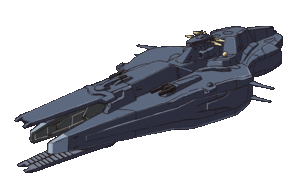
Adams-class Aviation Battleship
- Anti-Ship Armament: B
- Anti-Air Armament: B
- Defenses: B
- Mobility: D
- Craft Complement: A
- Electronics: C
- Originally built as a counterpart and competitor to the Kilimanjaro class, the Fuji class emphasised mobile weapon handling spaces over range and gunnery firepower. The primary contractors were in Jovian space and when the Jovian Republic declared its independence the yards and several partially-completed hulls were seized and rapidly put into service. Renamed the Adams class they were, for a time, the most advanced and powerful ships in Jovian service and until the late-war introduction of the Defiance class, the ships with the largest mobile suit complement.
- Several of these ships managed to escape internment and scrapping at the end of the war and despite their age form the nucleus of the Neo-Jovian Mobile Fleet. All have been refitted with modern electronics and defenses at [REDACTED] and draw a disproportionate number of skilled, veteran pilots.
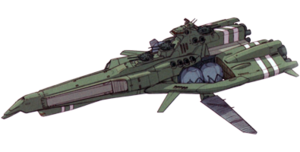
Los Angeles-class Cruiser
- Anti-Ship Armament: C
- Anti-Air Armament: C
- Defenses: C
- Mobility: C
- Craft Complement: C
- Electronics: C
- Widely viewed as the best cruiser of the System War, the Los Angeles class remains a viable cruiser to this day. Its replacement remains controversial, and upgraded models continue to be built for states throughout known space. It is well-armed and reasonably armored, but it has a less-efficient power system that hampers its endurance and maximum speed.
- Much of the longitevity of the class can be attributed to the fact that the Los Angeles design struck an excellent balance between systems; the resulting ship was an excellent jack of all trades. While this comes with the unfortunate corolary of 'master of none', the LAs also pioneered a number of naval architectural innovations and were robust, 'happy' ships in service. Built in limited numbers before the war, production was increased massively during wartime and it was extremely common for these ships to be fighting on both sides in the same battle. Originally fitted with railguns in their primary turrets, production soon switched to beam cannons. Their large onboard hangars (for a cruiser of the era) made them popular with admirals on both sides and their tactical flexibility kept them in heavy demand.
- Neo-Jove operates a number of Los Angeles class ships, all modified from their base specifications. The biggest upgrades have been to the power systems; all have gone through a comprehensive refit to replace the war-era fusion powerplants with more efficient modern models. This has improved their endurance, which is further augmented by extra reaction mass tanking.
Henderson Field-class frigate
Primary Operator: Neo-Jove, SolFed Clients
Role: Transatmospheric Light Assault Ship
Displacement: 16,970 tons loaded
Kinetic Defense: 3
Energy Defense: 3
Electronic Defense: 1
Melee Defense: 0
Speed: 3
Thrust: 5
Armor: 2
Vital Protection: 8
Shields: 2 (0 with scattering field deactivated)
Durability: 155
Targeting: 3
Electronics: 2
Stealth: -3 (-1 with scattering field deactivated)
Hangar Space: 16
Fixed Armament & Equipment
- G1 Scarlet Veil
- Light CIWS Array
- 1x G1 Twin Cannon Turret (Kinetic)
- 2x Torpedo Tubes
- 2x Quad AA Turrets
Wormhole Rating: 2
GC Generation: 1
GC Storage: 20
Cargo Stowage: 25
Float Rating: 1
Entering service as the new Federation frigate when the Solar War erupted, the Henderson Field was being built in Jovian shipyards and consequently became the new Jovian frigate. Rolled out of the shipyards as fast as possible, they were unimpressive in combat but gave the Jovians a substantial edge in extrasolar actions. One of their few features of note was the added ballistic calculators and step-down controllers for their dorsal railcannon turret, giving them the ability to use it as long-range ballistic artillery. Many Henderson Fields escaped out of the Solar System at the end of the war, with the balance being expended as target ships or forwarded on to client-states like the Republic of Cynus and the White Rose Kingdom.
Solar Federation
Continent-class Super Battleship Image
- Anti-Ship Armament: SS
- Anti-Air Armament: SS
- Defenses: SS
- Mobility: C
- Craft Complement: S
- Electronics: A
- The New Continent class high mobility Super Battleships are the most recent product of Sol's drive yards. Even larger than the Atlantic Class, there are so far only 2 of these massive vessels in service. Each one makes up the centre piece of one of the Federation's out system fleets. Currently the Asia patrols near White Rose Space, while the South America watches the League and Sagitarian borders.
Atlantic -class Assault Carrier Image
- Anti-Ship Armament: S
- Anti-Air Armament: S
- Defenses: S
- Mobility: D
- Craft Complement: S
- Electronics: C
- Combining the power of a battleship with the airwing of a fleet carrier, the Atlantic-class assault carrier is a fleet flagship built only in small quantities. Bristling with anti-capital and anti-suit ordnance, this ship is designed to survive even a full squadron's attacks.
Norway-class Battleship Image
- Anti-Ship Armament: A
- Anti-Air Armament: A
- Defenses: A
- Mobility: C
- Craft Complement: A
- Electronics: C
- The SFN mainline battleship is designed for leading smaller fleets and providing a heavy anti-capital ship strike capability. It was built to take into account modern mobile suit tactics, and thus carries more anti-suit weaponry and superior targeting compared to the previous generation of battleships, at the cost of only marginal increases in firepower. Combined with the large air wing, a Norway-class is a tough target for even an elite suit squadron.
Indonesia-Class Battleship
- Anti-Ship Armament: A
- Anti-Air Armament: A
- Defenses: A
- Mobility: B
- Craft Complement: A
- Electronics: S
- Resembling a scaled down Atlantic class, the Indonesia Class Battleships are in fact very different beasts. More capable of independent operations of the kind the SFSF now finds itself undertaking, Indonesia Class ships are faster and have heavily upgraded electronics without sacrificing any of a Norway's weapons or toughness. So far only a few of these expensive but excellent ships are in orbit, with the Japan being the only one stationed outside Sol and away from the League/Sagittarius boarder.
Rio De Janeiro-class Cruiser Image
- Anti-Ship Armament: C
- Anti-Air Armament: C
- Defenses: C
- Mobility: C
- Craft Complement: C
- Electronics: C
- The smallest vessels in SFN use to carry fighters, these ships are the core of the SFN fleet. Though capable of limited independent operations, they generally serve as battleship escorts and as mainline anti-pirate forces. They have been mass-produced, and the design has been extremely refined. The Rio De Janeiro-class has few weaknesses, but no true strengths.
London-class Heavy Cruiser Image
- Anti-Ship Armament: B
- Anti-Air Armament: C
- Defenses: C
- Mobility: B
- Craft Complement: B
- Electronics: B
- Vessels such the SFS Calais are heavy cruisers designed for long-range unsupported operations. They have large stores and fuel capacity, as well as a scaled down version of the battleship drive system and weapon emplacements. These ships also have superior sensors and ECM system compared to the rest of the fleet, as well as large suit hangars. Unfortunately, the armor on the London-class is fairly weak for its size, and they must rely on ECM and superior range to survive a capital ship onslaught.
Jane Tanner-class Destroyer
Image
- Anti-Ship Armament: D
- Anti-Air Armament: C
- Defenses: D
- Mobility: A
- Craft Complement: E
- Electronics: D
A simple escort craft built to serve as a guard against pirates and light craft, this class is easily outmatched by any cruiser, and is not durable enough to stand up to the attacks of an INTACT-level squadron. However, these little ships are designed for intercepting fast moving missiles and Raptor drones, and even the main armament is designed for anti-suit use.
Sir Draco Vorfeed-class frigate
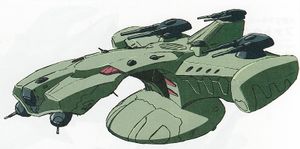
Primary Operator: INTACT
Role: Transatmospheric Light Assault Ship
Displacement: 16,030 tons loaded
Kinetic Defense: 4
Energy Defense: 4
Electronic Defense: 1
Melee Defense: 1
Speed: 3
Thrust: 6
Armor: 2
Vital Protection: 8
Shields: 2 (0 with flash fields deactivated)
Durability: 175
Targeting: 3
Electronics: 3
Stealth: -1
Hangar Space: 12
Fixed Armament & Equipment
- G2 Scarlet Veil
- Light CIWS Array
- 2x G2 Single Cannon Turrets (Energy)
- 1x G2 Twin Cannon Turret (Kinetic)
- 2x G2 Twin Cannon Turrets (Energy)
- 2x Dual AA Turrets
Wormhole Rating: 3
GC Generation: 1
GC Storage: 30
Cargo Stowage: 20
Float Rating: 2
Dating to the Martian War, the Sir Draco Vorfeed was taken up by the newly-founded INTACT in the aftermath of that intercine struggle. The last true combat frigate built in any numbers for the Federation, the 'Vorfeeds have served for most of two decades across a hundred star systems and are still a major - if relatively declining - component of the INTACT fleet. With a respectable turn of speed and full gravity-resist float capability - as compared to most earlier frigates which were limited to mostly up-and-down movements in a gravity well. Well-armed with a large number of beam cannons and a ventral hangar pod carrying up to six mobile suits and various ground vehicles, their one weakness is a limited anti-air defensive suite.
Cortes-class Landing Ship
Threat Level: D Image
Commonly used for major assaults, this class is built for aerospace operations and landing large quantities of troops on the ground. It is design to provide ground support, and has limited anti-air cover, so mobile suit escorts are required.
Condor-class Heavy Dropship
Threat Level: E Image
This shuttle is carried on most INTACT vessels, and is quite tough for its size. When the SFMC needs to get somewhere fast, it turns to these armed shuttles. They require air cover or active Mirage fields to survive a drop in a combat zone.
League of Outer Stars Fleet
Seyfert-series Forward Operations Vessel
- Anti-Ship Armament: D
- Anti-Air Armament: C
- Defenses: C
- Mobility: C
- Craft Complement: A
- Electronics: C
The standard 'cruiser' warship of the League of Outer Stars, these warships have served to protect the League for the past two decades. Relatively austere, by Solar standards they are lightly armed with only two beam turrets for anti-ship firepower. However, their onboard Raptor bays are impressively spacious. Production standardization has allowed for a surprisingly large number of these ships to be constructed and new hulls continue to enter service.
Newton-series Local Defense Vessel image
- Anti-Ship Armament: E
- Anti-Air Armament: D
- Defenses: D
- Mobility: B
- Craft Complement: C
- Electronics: D
The first mass-produced warship to serve the league, the Newton is a simple yet robust warship. Equipped with three small Raptor bays it can effectively patrol local space or support larger ships, though its lack of anti-ship firepower makes them easy prey for warships. Like most League ships, Newtons have a high degree of automation for non-critical functions and they regularly operate with only 20 crew. Their lack of endurance generally ties them to fixed bases or fleet resupply craft.
Union
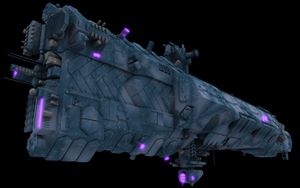
Cascade-series Heavy Cruiser
- Anti-Ship Armament: B
- Anti-Air Armament: A
- Defenses: C
- Mobility: B
- Craft Complement: B
- Electronics: S
- These hyper-modern heavy cruisers are the most sophisticated warships in the Verge, featuring overtechnology equipment and massive electronic warfare capabilities. Armed with missiles for long-range combat and an array of beam weapons for close fights they are very powerful for their size. A reinforced mecha squadron rounds out the ship's complement. Despite this high level of capability, there are persistent rumors that their combat software is buggy and prone to failure at irregular times.
Cyclone-series Destroyer
- Anti-Ship Armament: C
- Anti-Air Armament: D
- Defenses: D
- Mobility: B
- Craft Complement: E
- Electronics: D
- A light escort vessel, the Cyclone is dominated by a pair of heavy rail turrets, fully the size of those fitted to battleships. Designed solely as a gun platform, it is deployed in escort of larger warships and can easily emerge victorious over almost any other ship its size. Unfortunately it has little more than self-defense ability against fighters and mobile suits.
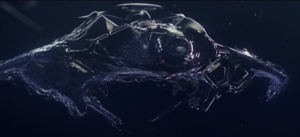
Acraomatic-series Prowler
- Anti-Ship Armament: D
- Anti-Air Armament: D
- Defenses: D
- Mobility: B
- Craft Complement: D
- Electronics: B
- Information is scarce about the Sagittan Union's small fleet of stealth operation vessels. Fitted with electromagnetic camouflage - the 'cloaking device' of science fiction - and low-emission drives they are believed to lurk around and outside the edges Union space, gathering intelligence. Best estimates give them unexceptional weapon loads and probably the ability to carry only a few mobile weapons, unsurprisingly given their presumed primary role as spy ships and minelayers.
Republic of Outremonde
Mackensen-class Battlecruiser
- Anti-Ship Armament: B
- Anti-Air Armament: A
- Defenses: A
- Mobility: B
- Craft Complement: C
- Electronics: B
Others
Naamah-class Research Frigate
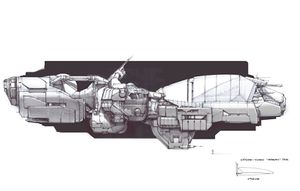
Primary Operator: Seraphim Organization
Role: Militarized Transatmospheric Multirole Ship
Displacement: 14-15,000 tons loaded (depending on specific fit)
Kinetic Defense: 5
Energy Defense: 4
Electronic Defense: 5
Melee Defense: 1
Helm: 4
Flight: 3
Thrust: 5
Armor: 2
Vital Protection: 4
Shields: 2 (0 with flash fields deactivated)
Durability: 125
Targeting: 0
Electronics: 5
Stealth: -1
Hangar Space: 12 + 4 aux stowage
Fixed Armament & Equipment
- Light CIWS Array
- 1x G2 Twin Cannon Turrets (Energy)
- 4x Quad AA Turrets
- 2x AA Missile Launchers
Wormhole Rating: 3
GC Generation: 1
GC Storage: 50
Cargo Stowage: 20 (40 if aux stowage is broken down)
Float Rating: 2
Civilian Version
Primary Operator: Seraphim Organization, Civilians
Role: Transatmospheric Exploration Ship
Displacement: ~17,000 tons
Kinetic Defense: 3
Energy Defense: 2
Electronic Defense: 1
Melee Defense: -2
Helm: 3
Flight: 3
Thrust: 4
Armor: 2
Vital Protection: 4
Durability: 125
Targeting: 0
Electronics: 5
Stealth: -1
Fixed Armament & Equipment
- Light CIWS Array
- 4x Twin AA Turrets
Wormhole Rating: 3
GC Generation: 1
GC Storage: 50
Cargo Stowage: 150
Float Rating: 2
- The Naamah is the standard Seraphim interstellar transport, a versatile design that entered service twenty years ago to replace the various prewar ships that the Seraphim were using at the time. Capable of atmospheric descent using onboard countergrav, equipped with rugged landing gear for rough-field landings and having large fuel reserves, the Naamah is ideal for use out in the Rim and beyond. Its hull is a fairly conventional cruciform shape, with fusion drives, CWD generator and fuel bunkerage in the after block. The two side blocks are independently self-contained living and operations sections, each with sufficient environmental hardware to support the entire ship. The bow block is the largest, consisting mostly of a spacious modular mission bay with the ship's primary sensors at the nose.
- A large number of Naamahs have been built, mostly for the Seraphim though an increasing number (often older, second-hand hulls) have entered service with other governments, organizations or private owners. The 'mission module' design lends itself to easy modification for more specialist roles. These frigates also serve as surrogate warships for the Seraphim, factory fitted to include combat-rated shielding, enhanced electronics and multiple weapons and typically acting as motherships for 4 to 8 mobile suits. While these ships cannot compete with purpose-designed warships in direct combat, they are capable enough to protect Seraphim interests in and around the various brushfire conflicts of the known galaxy.
Kilimanjaro-class Battleship Image
- Anti-Ship Armament: A
- Anti-Air Armament: B
- Defenses: A
- Mobility: C
- Craft Complement: B
- Electronics: D
The principle battleship of the SFN in the System War, the Kilimanjaro-class was a dreaded silhouette for the rebels and a symbol of Federation power afterward. With the commissioning of new Ares class battleships, the old warhorse was sold off to allied states. While a bit outdated, the Kilimanjaro-class is still a battleship capable of holding its own. Mobile Suit teams should engage these vessel only in a coordinated attack.
Los Angeles-class Cruiser
- In addition to being a major part of the Neo-Jovian fleet, the Los Angeles is common in a half-dozen national fleets of note. Furthermore, more than a dozen of these ships are believed to be entirely rogue, though how many remain combat-ready is unknown.
Beluga-class Submarine
Threat Level: C Image
Built in limited numbers by the White Rose Kingdom for sea patrol, this design has been used by a number of other states, and the SFN is designing an improved version. The aquatic environment plays to these ships, and makes them dangerous against non-optimized ships. Using the ocean as a heat sink lets them mount deadly beam weaponry and supercavitating flak arrays. It is relatively slow and lacks agility, however.
Astute-class Battleship Image
- Anti-Ship Armament: B
- Anti-Air Armament: D
- Defenses: B
- Mobility: D
- Craft Complement: E
- Electronics: D
An old ship of the line from the era prior to the System War, this ship is still a threat to smaller capital ships. During its era, the heavy particle turrets were amazingly destructive, but that era has long passed. It has no internal fighter bay and outdated flak guns, and is thus very weak to a mobile suit attack.
Fulton-class Destroyer Image
- Anti-Ship Armament: E
- Anti-Air Armament: D
- Defenses: D
- Mobility: A
- Craft Complement: E
- Electronics: E
An old mass-produced destroyer from the early SFN, the Fulton-class has only a few light pulse cannons for armament. With its large cargo hold and high-speed engines, it has become more popular for piracy and smuggling than it ever was in the SFN.
Skinner-class Escort Image
- Anti-Ship Armament: D
- Anti-Air Armament: D
- Defenses: E
- Mobility: A
- Craft Complement: E
- Electronics: E
The Skinner class is an old patrol ship built en-masse by the Space Independence Alliance. Lightly armed with a trio of large-caliber autocannons for mobile suit defense, their torpedoes can still pose a threat to larger ships. Obsolete in the new SolFed fleet, most of these craft were refitted with a jump drive to give them interstellar range and moved to outsystem colonies for local defense, where a substantial number eventually went rogue or were captured by pirates. As such they represent a fairly typical light pirate ship.